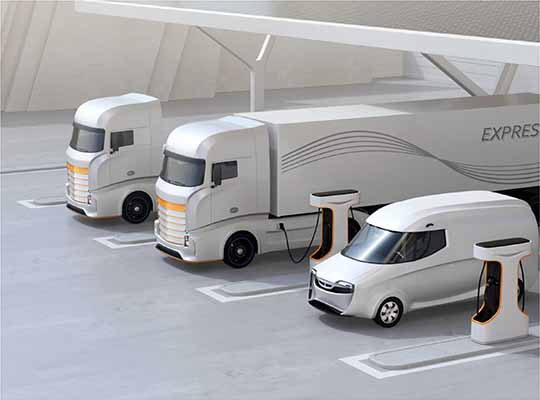Multiple efforts are underway to develop electrical components that will enable the design of commercially viable medium- and heavy-duty electric vehicles (MHDVs). Vehicles classified as MHDVs range from walk-in delivery vans to transit buses and long-haul trucks. Power electronics and energy-storage technologies being developed for MHDVs will benefit other application areas such as smart grids, microgrids, renewable energy, grid-scale energy storage, industrial systems, and even light-duty vehicles (LDVs) such as passenger cars. Let’s review the power options for MHDVs.
Performance Targets for Batteries, Motors to be Aggressive
MHDV electrification is in its early stages, and technical performance targets for MHDVs are under development. They are expected to be more aggressive than the current targets set for passenger vehicles (Table 1). Also, MHDV targets will be expanded to take into consideration the different expectations that fleet owners will have for MHDVs, including increased reliability and greater ruggedness when operated under harsh conditions for extended periods, such as over 1 million miles on the road.
Battery voltages are already rising for LDVs, from today’s 350V and 700V to power buses up to 900V in some cases. For MHDVs, the voltages are expected to be higher, up to 1,200V. Higher voltage power buses are important for reducing the size, weight, and cost of components such as bus bars, inductors, and motors.
Higher voltages are required to support emerging extreme fast charging (XFC) for LDVs, and the even higher voltages of MHDVs will support fast (or flash) charging technologies. Fast-charging batteries will require substantially more power compared to current XFC technologies for LDVs (350kW), much greater than a megawatt. This presents new challenges and requires much higher power chargers, connectors, and infrastructure than currently considered for LDVs. In addition, thermal management will be more crucial and complex at high charge rates.
Today’s 600V- and 1,200V-rated silicon carbide (SiC) power semiconductors are not suitable for 1,200V power buses. The higher bus voltage will require the development of 1,700V SiC MOSFETs, which are just coming to market. For 1MW applications being envisioned with direct connection to 1,200V mains power, devices rated even higher than 1,700V might need to be developed. Higher voltage power semiconductors will benefit from advanced industrial processes and smart grid, microgrid, grid-scale energy storage, and renewable energy systems.
Motors that can deliver higher power densities at lower costs are also needed for broad-based MHDV deployment. Today’s heavy rare earth (HRE) permanent-magnet motors (PM) are not expected to meet both performance and cost requirements. Even meeting USDrive’s goals for LDVs, as indicated above, might not be possible using HRE PMs. Research is underway to develop motors that do not use HRE PM technology and can even eliminate permanent magnets while at the same time being able to operate in harsh and demanding environments. Improved performance and lower cost motors will directly benefit numerous industrial applications, as well as MHDVs and LDVs.
The weight, cost, and cycle life of battery packs based on today’s technology are not suitable for widespread deployment in MHDVs. Emerging solid-state batteries are one possible solution. Advanced lithium batteries such as Nickel Manganese Cobalt Oxide (NMC) Li-ions might be capable of 1 million miles and 20-year lives and could present another option. Significant improvements in battery performance are necessary for MHDV adoption and will directly benefit other applications, such as microgrids and grid-scale energy storage.
Conclusion
The development of the various technologies to enable the commercial development of MHDVs is a major undertaking. The degree to which this effort is successful will result in spin-off benefits for other application areas such as smart grids, microgrids, renewable energy, grid-scale energy storage, industrial systems, and even LDVs.
About the author:
Jeff has been writing about power electronics, electronic components, and other technology topics for over 30 years. He started writing about power electronics as a Senior Editor at EETimes. He founded Powertechniques, a power electronics design magazine with a monthly circulation of over 30,000. He subsequently founded Darnell Group, a global power electronics research and publishing firm. Among its activities, Darnell Group published PowerPulse.net, which provided daily news for the global power electronics engineering community. He is the author of a switch-mode power supply textbook, titled “Power Supplies,” published by the Reston division of Prentice Hall.
Jeff was co-founder of Jeta Power Systems, a maker of high-wattage switching power supplies acquired by Computer Products. Jeff is also an inventor. His name is on 17 U.S. patents in the fields of thermal energy harvesting and optical metamaterials. He is an industry source and frequent speaker on global trends in power electronics. He has been invited to speak at numerous industry events, including the Plenary Session of the IEEE Applied Power Electronics Conference, Semicon West, Global Semiconductor Alliance Emerging Opportunities Conference, IBM Power and Cooling Symposium, and Delta Electronics Senior Staff Seminar on Global Telecommunications Power. Jeff has a Masters Degree in Quantitative Methods and Mathematics from the University of California, Berkeley.


















